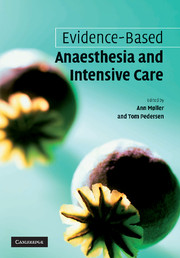Book contents
- Frontmatter
- Contents
- Foreword
- Contributors
- 1 Introducing evidence-based anaesthesia
- 2 How to define the questions
- 3 Developing a search strategy, locating studies and electronic databases
- 4 Retrieving the data
- 5 Critical appraisal and presentation of study details
- 6 Outcomes
- 7 The meta-analysis of a systematic review
- 8 Bias in systematic reviews: considerations when updating your knowledge
- 9 The Cochrane Collaboration and the Cochrane Anaesthesia Review Group
- 10 Integrating clinical practice and evidence: how to learn and teach evidence-based medicine
- 11 Involving patients and consumers in health care and decision-making processes: nothing about us without us
- 12 Evidence-based medicine in the Third World
- 13 Preoperative anaesthesia evaluation
- 14 Regional anaesthesia versus general anaesthesia
- 15 Fluid therapy
- 16 Antiemetics
- 17 Anaesthesia for day-case surgery
- 18 Obstetrical anaesthesia
- 19 Anaesthesia for major abdominal and urological surgery
- 20 Anaesthesia for paediatric surgery
- 21 Anaesthesia for eye, ENT and dental surgery
- 22 Anaesthesia for neurosurgery
- 23 Cardiothoracic anaesthesia and critical care
- 24 Postoperative pain therapy
- 25 Critical care medicine
- 26 Emergency medicine: cardiac arrest management, severe burns, near-drowning and multiple trauma
- Glossary of terms
- Index
25 - Critical care medicine
Published online by Cambridge University Press: 05 September 2009
- Frontmatter
- Contents
- Foreword
- Contributors
- 1 Introducing evidence-based anaesthesia
- 2 How to define the questions
- 3 Developing a search strategy, locating studies and electronic databases
- 4 Retrieving the data
- 5 Critical appraisal and presentation of study details
- 6 Outcomes
- 7 The meta-analysis of a systematic review
- 8 Bias in systematic reviews: considerations when updating your knowledge
- 9 The Cochrane Collaboration and the Cochrane Anaesthesia Review Group
- 10 Integrating clinical practice and evidence: how to learn and teach evidence-based medicine
- 11 Involving patients and consumers in health care and decision-making processes: nothing about us without us
- 12 Evidence-based medicine in the Third World
- 13 Preoperative anaesthesia evaluation
- 14 Regional anaesthesia versus general anaesthesia
- 15 Fluid therapy
- 16 Antiemetics
- 17 Anaesthesia for day-case surgery
- 18 Obstetrical anaesthesia
- 19 Anaesthesia for major abdominal and urological surgery
- 20 Anaesthesia for paediatric surgery
- 21 Anaesthesia for eye, ENT and dental surgery
- 22 Anaesthesia for neurosurgery
- 23 Cardiothoracic anaesthesia and critical care
- 24 Postoperative pain therapy
- 25 Critical care medicine
- 26 Emergency medicine: cardiac arrest management, severe burns, near-drowning and multiple trauma
- Glossary of terms
- Index
Summary
This chapter will deal with a selection of topics, which are currently of practical and scientific importance. We discuss respiratory support including indication and conditions requiring respiratory support, examine the choice of artificial airway (tracheal tube, mask, tracheostoma). We present practical examples of ventilation strategies: lung-protective ventilation for acute respiratory distress syndrome (ARDS) and non-invasive ventilation for obstructive lung disease (OLD). Weaning from respiratory support will end this part.
Antibiotic therapy can be used as prophylactic therapy or to treat manifest sepsis. The current concept of initial empirical antimicrobial therapy and de-escalating strategy will be described. The part dealing with nutrition contains the steps necessary in practice: estimating the required energy, deciding kind of nutrient and route of administration, and management of problems. We will demonstrate that evidence regarding Vasopressors is sparse and give some practical information for treating cardiac arrest and septic shock.
Antithrombotic therapy goes beyond heparin alone. We exemplify this for deep vein thrombosis and sepsis.
Respiratory support
Indication for respiratory support
Some vague guidance is available to decide whether respiratory support should be provided to the individual patient. Nonetheless it is important to mention here that – on top of the available evidence – patient centredness, ethical considerations, and critical assessment of the actual situation are necessary to appropriately supply this core element of intensive care medicine.
Keywords
- Type
- Chapter
- Information
- Evidence-based Anaesthesia and Intensive Care , pp. 321 - 342Publisher: Cambridge University PressPrint publication year: 2006



